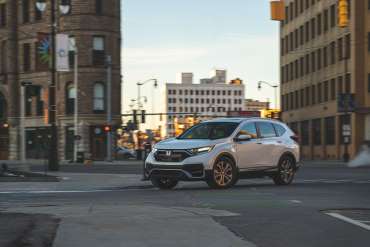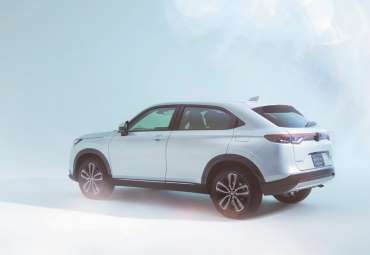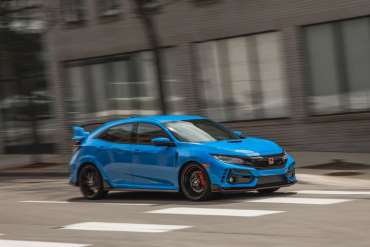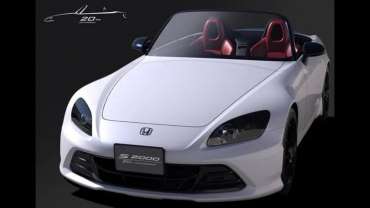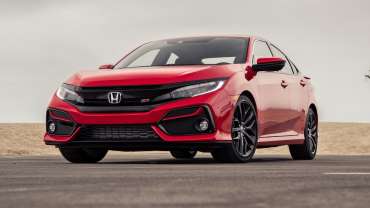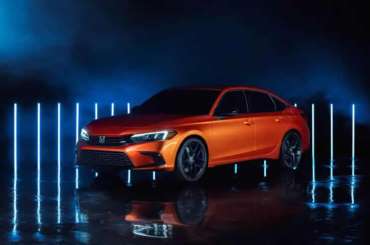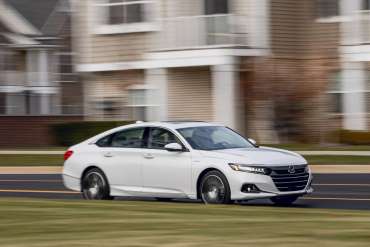Displaying items by tag: Honda
A 2021 Honda CR-V Hybrid Sidles into Our Long-Term Fleet
We begin a 40,000-mile shakedown of Honda's first electrified crossover to see if the powertrain scales up into the brand's bestselling vehicle.
Introduction
We invited a 2021 Honda CR-V to join our long-term fleet so we could spend some quality time (and 40,000 miles) with Honda's bestseller and the fifth-bestselling vehicle in the United States. We chose the hybrid because it's new to the lineup and because we liked the 212-hp fuel-sipping powertrain in the Accord. In the CR-V, the system boosts fuel economy and performance, making it the choice for buyers who want efficiency and power. Those customers will have to shell out for it, though, given the CR-V Hybrid sits at the top of the range. In addition to shaking down the powertrain and seeing if it can deliver the promised fuel economy, we're hoping this compact crossover—the brand's first with hybrid power to make it to the U.S.—will give us a glimpse at the future of Honda, which will soon phase out gas-only powertrains in Europe.
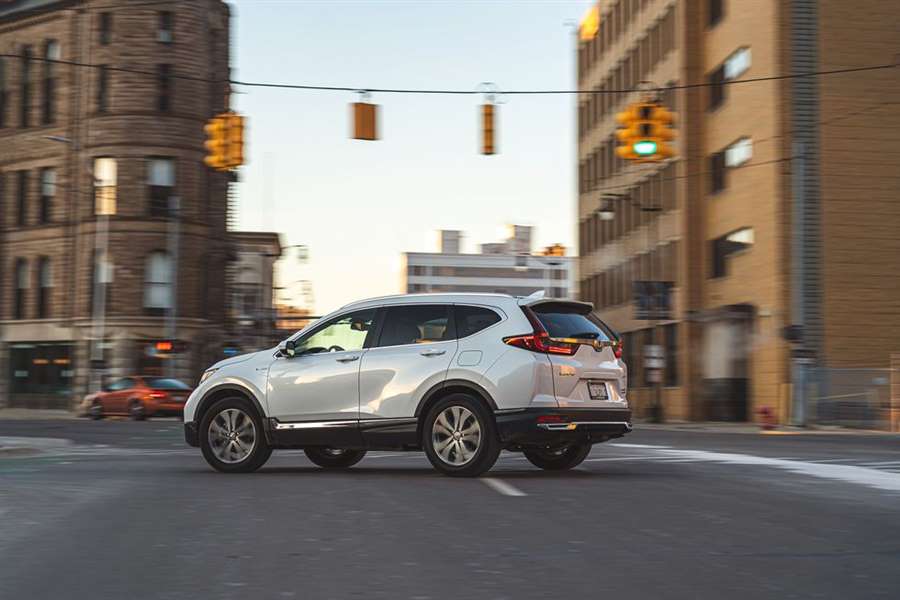
We ordered a top-of-the-line Touring model loaded with just about everything: leather seats (heated up front), navigation, wireless phone charging, Android Auto and Apple CarPlay integration, a nine-speaker audio system, a liftgate that opens when you wave your foot under the bumper, proximity key entry, remote start, the Honda Sensing suite of driver-assistance features, and more. Our $37,920 example has but one option: white paint for $395. Perhaps it's because all of southeast Michigan is currently covered in two feet of snow or because half the vehicles in the grocery-store parking lot are also painted in America's favorite automotive hue (and shaped like tall boxes), but the CR-V blends in a little too well with its surroundings. We wouldn't call the color choice regrettable but maybe a bit forgettable.
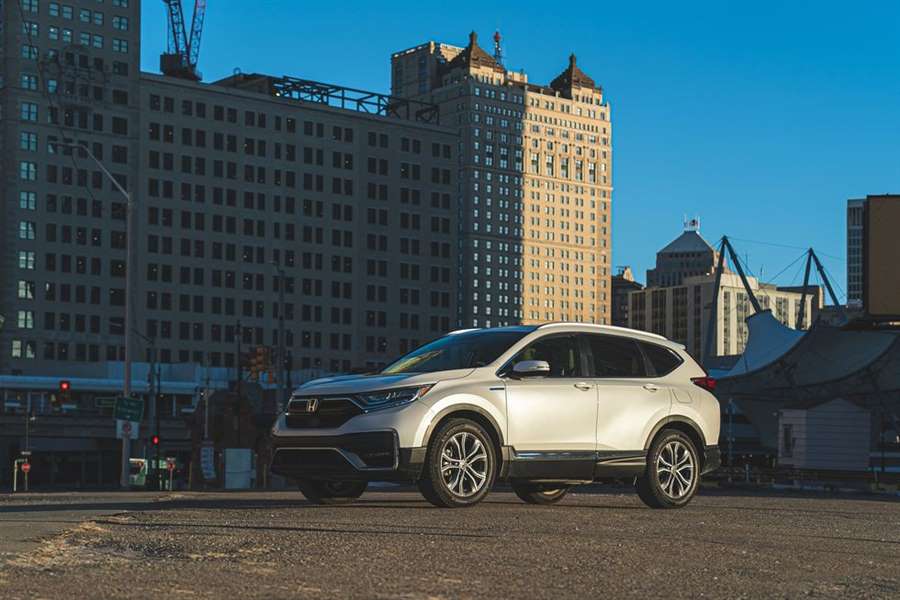
Inside, Honda's inoffensive design, easy-to-use 7.0-inch touchscreen, and highly adjustable center console should satisfy most shoppers in this class if not the nit-pickiest staffers on our masthead. Hybrid versions differ from regular CR-Vs in a few subtle ways. A unitless battery gauge replaces the tachometer in the digital instrument cluster and tells you vaguely how much juice you're using at any given moment. Honda also opted for a push-button transmission instead of the chunky gear lever used in the core model. Staff reaction to push-button shifters is mixed, but the setup at least makes for a tidy, unobtrusive center console. In the same way a light color creates the illusion that a room is larger than it is, the Ivory surfaces in our CR-V make the cabin appear adequately spacious, which, granted, it is, offering 103 cubic feet of passenger volume. Provided that light-beige leather can withstand the dye in our Levis, the simplicity of this interior all but ensures it will age well.
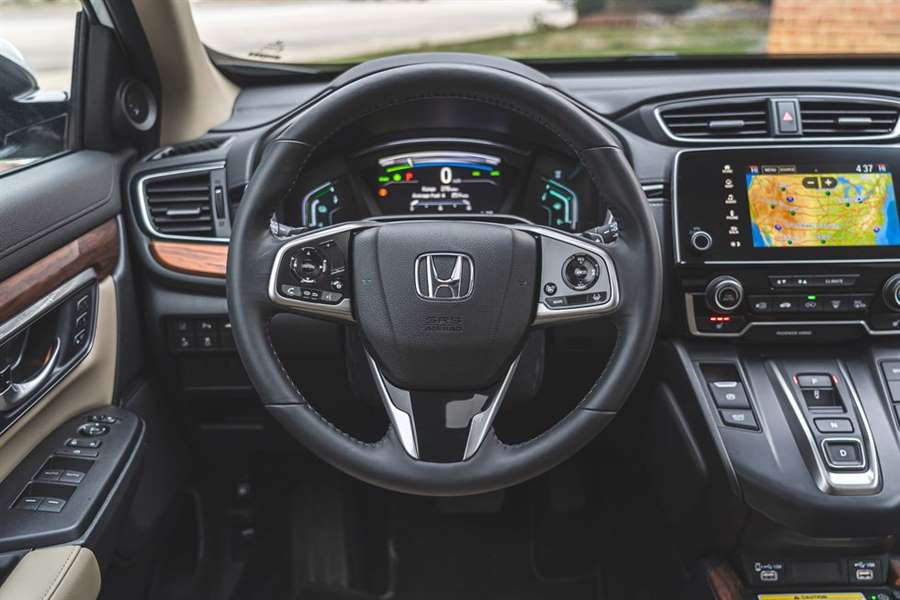
A couple of hybrid caveats to note: Choosing this powertrain nullifies the nonhybrid CR-V's 1500-pound tow rating, so technical editor David Beard will have to look elsewhere when he wants to tow his snowmobile. Which is just as well, considering the cargo hold probably wouldn't fit all of his gear. The gas-electric CR-V sacrifices six cubic feet of cargo space (and its spare tire) to the battery. The upside is that, compared with a regular all-wheel-drive CR-V, you gain 9 mpg in combined driving by the EPA's yardstick. That said, if you drive like we do, you can expect much worse results: We're currently averaging a mere 27 mpg.
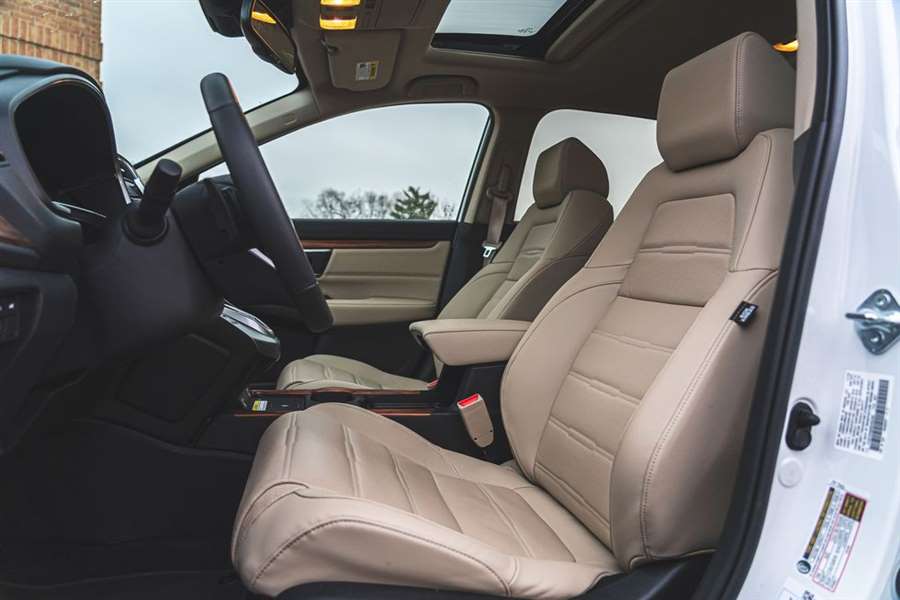
The Honda's road manners are in line with the amiable-but-boring norm of the segment. Its smooth ride and secure handling are immediately apparent, but there's nothing here that'll make an enthusiast grin—unless of course you're reading its VIN, which by dumb luck contains a bit of bathroom humor. Floor the accelerator and the powertrain fills the cabin with 75 decibels of sound. That's quieter than the regular CR-V's 78-decibel moan at full throttle.
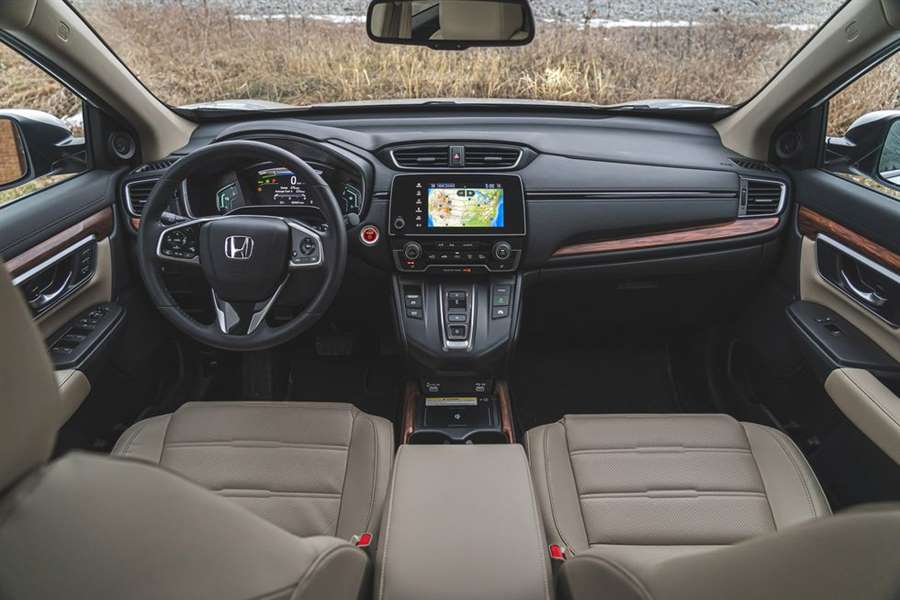
Due to COVID-19 restrictions, we haven't had as many butts in these seats as we'd like, but after soft-shoeing it through the break-in period, we sent the Honda to the test track. The hybrid's drive motor can contribute 232 pound-feet of torque from the get-go, which helps this ute reach 60 mph a tenth of a second quicker than the unelectrified model, but the latter catches up by 70 mph and pips the hybrid at the quarter-mile, 15.9 seconds to 16.1. Our long-termer also lagged behind the regular CR-V in braking (170 feet versus 165) and roadholding (0.80 g versus 0.85). Given both cars wear identical Continental CrossContact LX Sport tires, we suspect the hybrid's extra 190 pounds are primarily to blame. Fortunately, in the real world, this CR-V seems more athletic than the gas-only version, and its quicker 5-to-60-mph time bears that out. As we put more miles on the odometer, we hope to see some of these numbers improve—particularly the observed fuel economy.
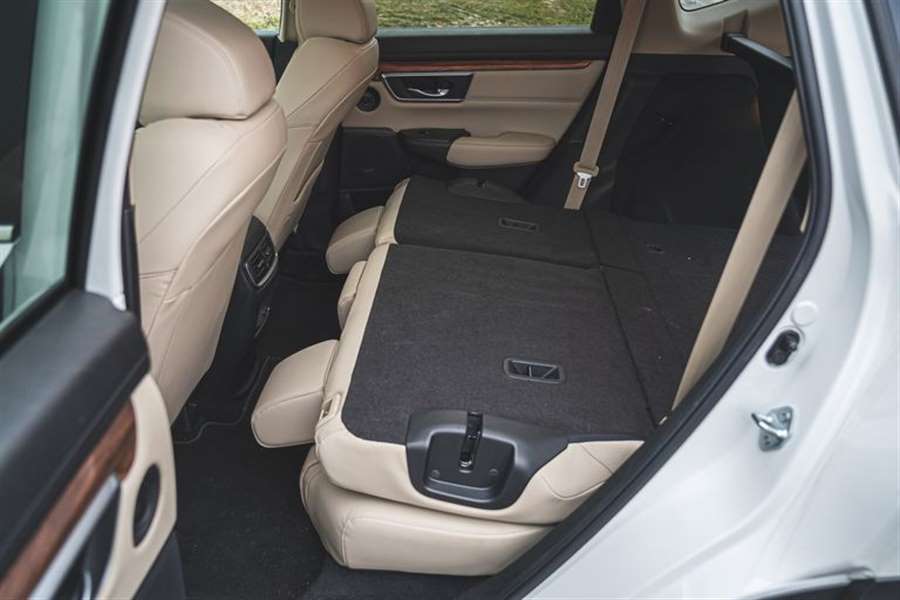
Months in Fleet: 2 months Current Mileage: 5131 miles
Average Fuel Economy: 27 mpg
Fuel Tank Size: 14.0 gal Observed Fuel Range: 370 miles
Service: $0 Normal Wear: $0 Repair: $0
Damage and Destruction: $0
Quite different: Honda unveils new HR-V hybrid (PHOTO)
Honda has unveiled a new generation of its compact crossover HR-V. In addition to the new design, this model will be offered as a hybrid electric vehicle, and it will arrive in Europe at the end of 2021.
The introduced HR-V is the latest model in Honda's range that bears the emblem e: HEV (hybrid electric vehicle). In addition, now this compact crossover comes for the first time with a rather accentuated coupe line.
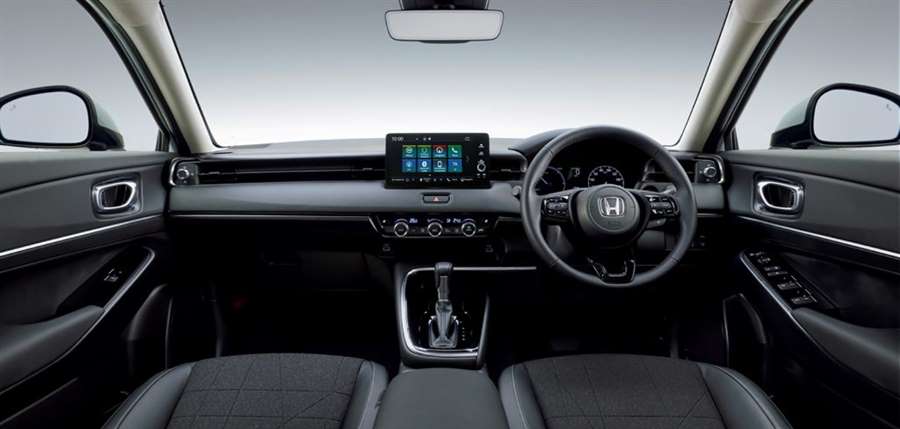
It also has a new integrated radiator grille, a long, lower hood and sharper, more vertical lines that have allowed this model to retain a spacious interior for four passengers, as offered by its predecessor.
The new HR-V also retains the familiar seats, which can provide a flat boot floor after folding down the backrest or folding up. Capacity data has not yet been disclosed.
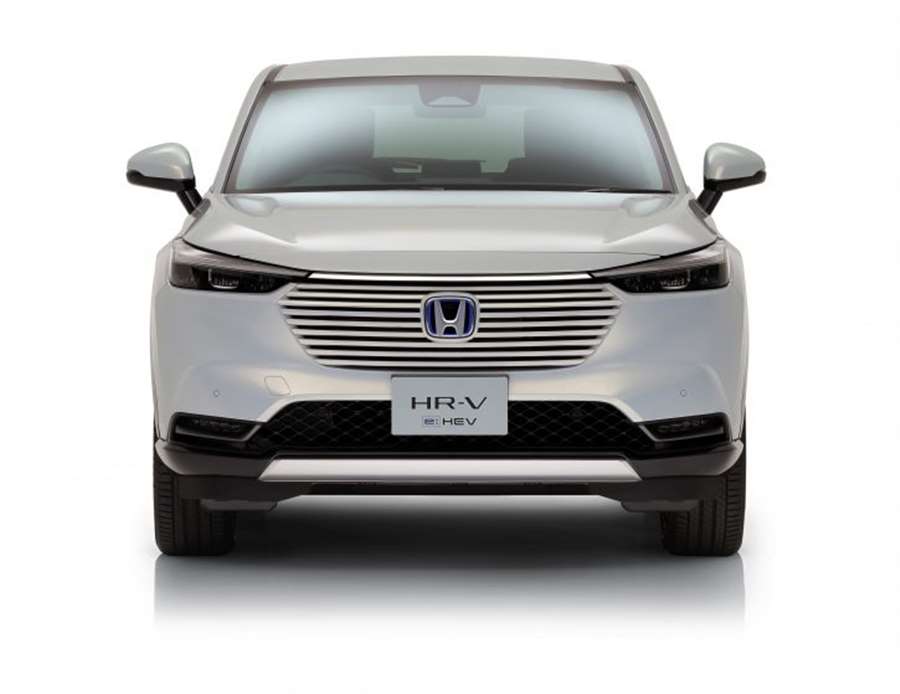
The cabin is now modern and minimalist with a horizontal instrument setup.
A new crossover, in line with Honda's goals of electrifying all major models by 2022, is expected on the European market later this year.
Tested: 2020 Honda Civic Type R Refines a Great Hot Hatch
Honda makes the bonkers Civic even better by adding features, retuning the chassis, and tweaking the hatchback's still polarizing styling.
Everyone is seeking a distraction these days. The crumbs collecting in the seat of our racing simulator and the growing pile of empty cans beside it suggest that we've spent an unhealthy number of hours lapping computerized cars around circuits in Forza Motorsport. Perhaps it's the fleeting pleasure those pixelated races provide that made our hands-on experience with the revised 2020 Civic Type R feel like Honda gave us a healthier way to seek catharsis.

In southeast Michigan, our favorite paved playground, the loop we employ to select our 10Best list every year, lives close by. The drive there includes enough highway time to allow plenty of peepers to gawk at the Type R's gloriously juvenile bodywork. Its bulging front fenders, countless aero bits, and distracting (yet functional) wing are made more obvious by the Type R's new brilliant Boost Blue hue, which is the least subtle update Honda introduced on the 2020 Type R. (We expect an all-new Civic Type R for the 2022 model year). Other exterior revisions include body-colored trim on both bumpers, a larger grille opening that improves engine cooling, and, to add back some lost downforce from the new grille, a reshaped front spoiler. While nothing will ever convince the haters that this Civic looks badass, it's hard to deny that the Japanese-designed Batmobile draws as much attention as significantly more expensive metal. Apart from some dealer-installed accessories, the no-cost paint colors are the only options. Our 2020 copy cost $37,990, which is only $735 more than it did last year.
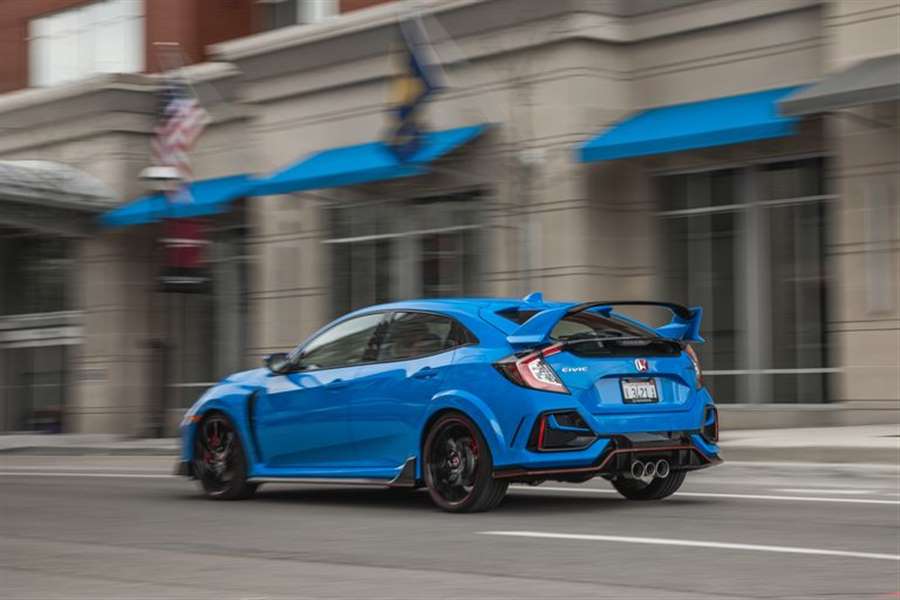
HIGHS: Unflappable poise, excellent turbo-four engine, daily driver livability.
The Type R looks as out of place on the interstate as Marilyn Manson performing at Sunday service. Although our long-term 2019 Civic Type R has revealed that extended road trips are not this car's strong suit, we had just a short interstate blast in the 2020 car before we reached our destination. Those outrageously red front seats are more comfortable than they look. And like lesser Civic hatches, the Type R has an Uber-grade back seat and sizable cargo space behind it. The 2020 model replaces the leather on the steering wheel and shift boot with a racier microsuede material. A new teardrop-shaped shifter hides a 90-gram counterweight to deliver better feel. Somewhat surprisingly, Honda kept the aluminum knob, which burns your hand in the summer and bites it in the winter.
The 2020 Type R's turbocharged 2.0-liter inline-four makes the same healthy 306 horsepower and 295 pound-feet of torque as before. That power is dispatched to the front wheels through a helical limited-slip differential and a six-speed manual transmission, which has short gearing that prioritizes rapid acceleration. While the engine starts making power around 2500 rpm, the party is pretty tame until the tach needle passes 3500 rpm, unleashing a thrilling blast to redline that conjures the high-revving VTECs of yore. It also provides enough shove to ensure that the Daewoo Lanos with a duct-taped wing that's lingering in your mirrors can only dream about overtaking you.
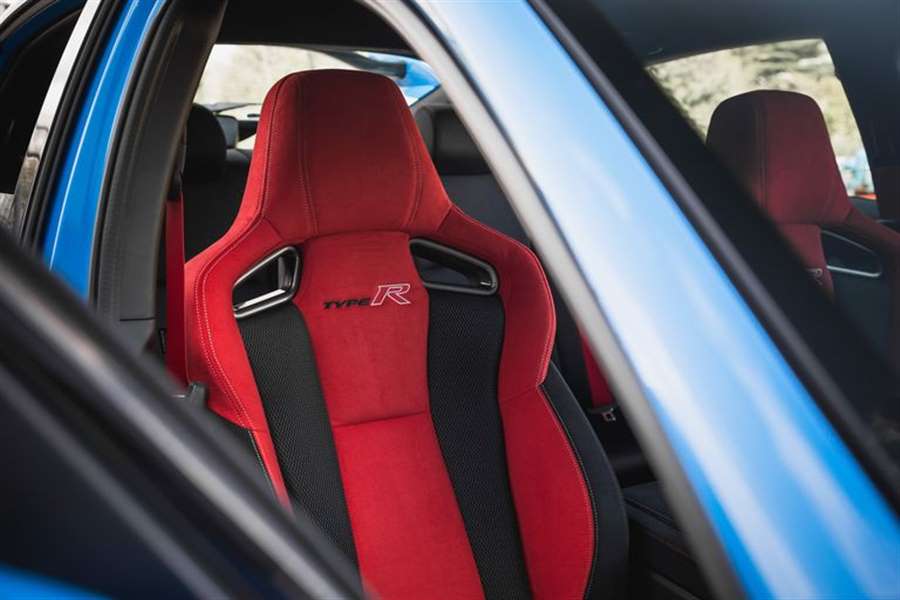
In the 2020 model, we recorded a 4.9-second dash to 60 mph and a quarter-mile pass of 13.4 seconds at 108 mph—solid runs that are both impressive for a front-wheel-drive car and similar to those of previous Type Rs we've tested. But the hottest Civic's reign as the quickest front-driver has come to an end. The updated 2021 Hyundai Veloster N with its new optional automatic transmission just beats the Honda to 60 mph by a tenth of a second. The 302-hp 2020 Mini John Cooper Works GP is a tenth quicker still to 60 mph (4.7 seconds) and posts an even stronger 13.1-second quarter-mile at 110 mph. Even more significant is that the Mini GP snagged the title of fastest front-driver ever at this year's Lightning Lap, beating the Type R's time around our 4.1-mile configuration at Virginia International Raceway by just 0.1 second.
LOWS: No longer the quickest hot hatch, love-it-or-hate-it styling persists, still doesn't sound as good as it drives.
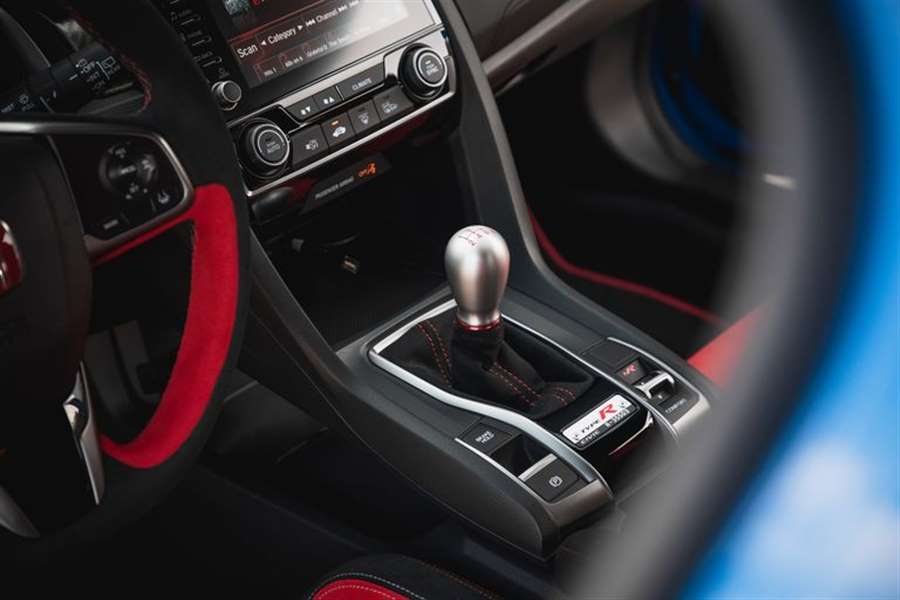
The Type R’s trademark triple-outlet exhaust issues a droning boom unless you’re working the engine hard enough to push exhaust through the center pipe and its resonator. The odd arrangement is intended to add character to the engine's soundtrack, but it only emphasizes our disappointment. The mightiest Civic sounds subdued, especially compared with the firecracker soundtrack of the Veloster N. Honda apparently realized this disparity and sought redemption by installing Active Sound Control on all 2020 models. This new feature artificially enhances the Type R's engine sounds using the audio system, and the intensity increases as you move through the drive modes. Too bad it's really only noticeable during large blips of the throttle—during heel-and-toe maneuvers or rev-matched downshifts—but even then, it just sounds like an auto-tuned bumblebee blasting from the speakers. The 88 decibels we recorded at full-throttle and 74 decibels at a 70-mph cruise are in line with other Type Rs we've measured, although those figures are 3 and 2 decibels quieter, respectively, than what our long termer produced when it was new.
As we approached the hard right turn that begins the clockwise circulation of the loop, we killed the climate system and the radio to focus on the Type R's chassis improvements. The 2020 car gets new lower-friction ball joints and updated bushings for the front suspension, revised rear bushings that are stiffer laterally, and retuned adaptive dampers that now sample the road 10 times quicker. The front brakes are fitted with more fade-resistant pads and new two-piece floating rotors that are no longer cross drilled that cut unsprung weight by 2.5 pounds per side. These careful tweaks are hard to perceive without driving the new and old models back-to-back, and they don't produce any measurable difference at the test track. The 2020 model returned a familiar (and excellent) 1.03 g of grip around the skidpad and a 148-foot stop from 70 mph. However, we did notice the new car's firmer brake pedal, which Honda says has 17 percent less initial lost motion before the pads meet the rotors (and the Type R already had spectacularly good brake feel).
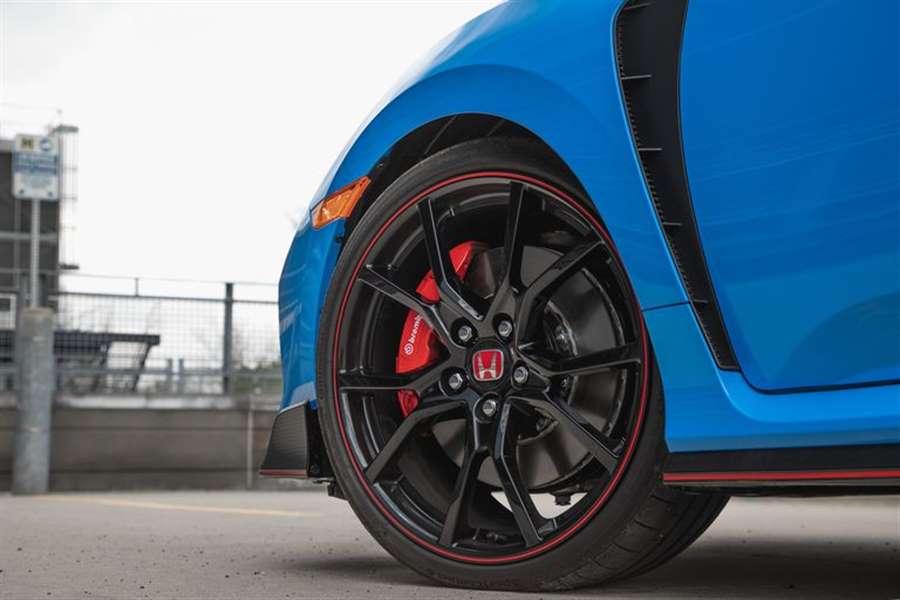
Our route includes several places where you can accelerate hard from a stop, and that’s one of the few situations where the Type R’s front-wheel-drive layout feels like a liability. The car's Continental SportContact 6 tires—sized 245/30ZR-20 all around—frantically scramble for traction as the turbo spools up and the tach approaches the 7000-rpm redline. While the front tires struggle to find grip right off the line, they’re at least not tugging toward the ditch, as the Type R's dual-axis strut front suspension magically vanquishes the dreaded front-drive torque steer. Once you’re moving, flowing along a ribbon of twisty road in third gear, the lack of all-wheel (or rear-wheel) drive feels irrelevant.
Despite pancake-thin sidewalls and huge 20-inch wheels, the Type R’s ride is almost unbelievably free from the expected jolts and jitters. While there's a noticeable change between the softest damper setting (Comfort) and the firmest (Plus R), the Civic feels unflappable in either mode while roller-coasting up and down the loop's esses. Steering effort incrementally increases with each of the three drive modes (the default, appropriately, is Sport) and every note reminds us of Porsche's divine composition.
The talkative wheel is a major factor in the Type R's preternatural ability to turn any road into a racetrack. This is a car that transforms grocery runs into hot laps, commuting into rally stages. While it shares an aging infotainment system and its standard driver-assistance features (such as adaptive cruise and lane-keeping assist, which are new for 2020) with the regular Honda Civic hatch, the alpha-dog model looks and feels like an altogether different car. It’s a raw, visceral machine, an IRL antidote to virtual living. You might have a million-dollar racing simulator, but those screens can’t compare with the view through a Type R’s windshield.
A NEW HONDA S2000 COMING IN 2024!?
Reports have said the Honda Roadster could be reborn
It's been 11 years since Honda's record breaking roadster went out of production. This has left the Mazda MX-5 in a league of its own being an entry level sports car, with open air thrills. After years of asking for at least a successor, it seems Honda has responded.
According to a Forbes report, a source "close to Honda" told them that Honda's marketing team members are, "seriously considering", bringing the S2000 out of retirement in 2024. That launch year would mark the 25th anniversary of Honda's beloved roadster, which would be very good timing.
The Forbes report also states that it's proportions are rumored to be similar to that of the original S2000, but be lighter by using aluminum and carbon fibre with a rumored weight below 3000lbs (1360kg). It will also supposedly be more powerful too but instead of using a high revving naturally aspirated I4, it will supposedly use a tweaked version of the current Civic Type-R's 2.0L turbocharged I4 which is currently pushing 320hp and 295 lb-ft of torque. Honda is reportedly looking at pushing that power figure up to 350hp for the S2000. Sure it might not scream all the way to 9000rpm anymore which is always glorious to hear, more power and forced induction is never a bad thing.
If all of these things are true, it will probably blow out any competition that it would have. It would no longer be an entry level sports car like the MX-5 or BRZ/GR86. The power figure and probable price for a new version of the car would put it in competition with the GR Supra or even the new Nissan Z which will be out by that point especially if Nissan decides to make a convertible version of it.
Keep in mind that this is all rumors at this point and to take with a grain of salt but let me know what you think of this in the comments. Don't forget to give this article a bump and don't forget to follow me for more content like this.
Source:drivetribe.com
2020 Honda Civic Si Long-Term Review: The Goldilocks of Sports Sedans
Minor concessions in comfort return huge gains in driver engagement.
Buying a performance car often costs more than money; it costs comfort and convenience. If you're buying a 2020 Honda Civic Si, though, it doesn't have to.
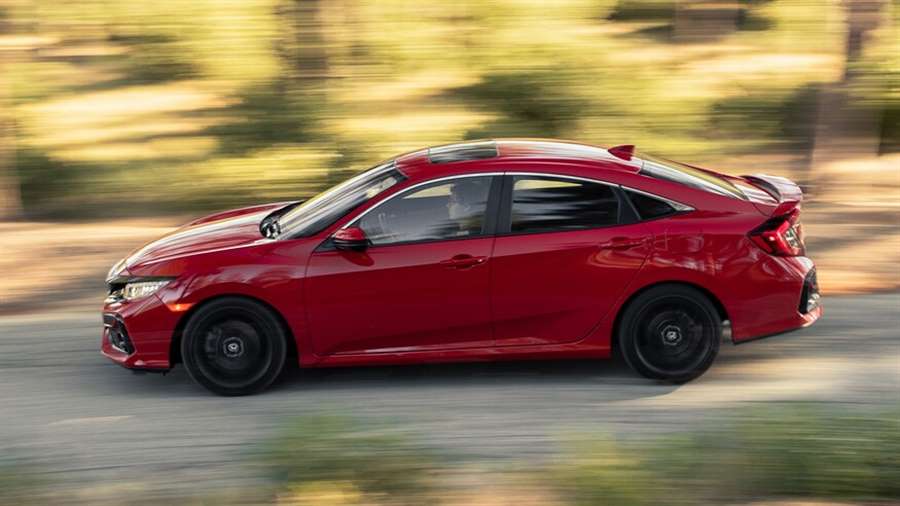
The Civic Si is essentially a mono-spec vehicle. As such, it rings in at just $26,155, making it one of the cheapest sports cars on the market in the best way possible. For that price, you get 31 more horses than a standard Civic, two-mode electronically controlled dampers, and a limited-slip differential. We spec'd ours with the $200 High-Performance Tire (HPT) option, but aside from that, all you could add to this car are some dress-up parts, a wireless phone charger, and an auto-dimming rearview mirror. The last two would've been nice, but we easily lived without them.
2020 Honda Civic Si: The Cost Of Caring
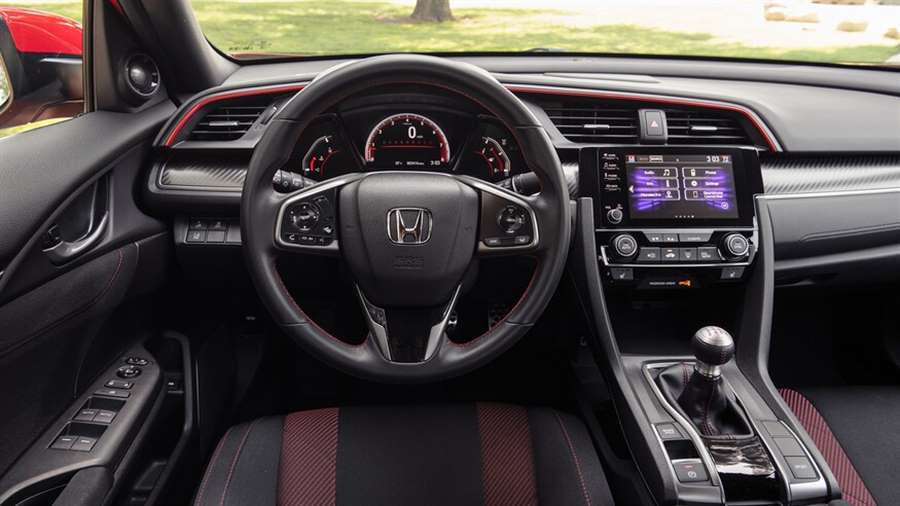
The Civic Si doesn't cost much in terms of comfort, either. The standard setting for the adjustable shocks is firmer than that of the average compact sedan, but not much. The shocks get firmer still in Sport mode, but that's just for when you're pushing the car on a good road. The front seats have big bolsters on the sides to keep you in place, but they're big, soft pads, not rigid extensions. If the Si is any louder inside than a standard Civic, it's not enough to notice (interior noise has long been a Civic weak spot).
The Civic Si costs almost nothing so far as convenience is concerned—provided you don't consider driving a stick shift in traffic inconvenient. In sedan guise, it gives up nothing in rear-seat space or access, and you get a big, secure trunk. And although there's no navigation option, it does come with Apple CarPlay and Android Auto compatibility so you can use your phone's navigation instead.

In fact, the Civic Si is comfortable and convenient enough that my wife and I didn't have a second thought about taking it on a three-hour journey to celebrate our anniversary at a house—with a pool—we rented. I thought for sure we'd stuff the car to the roof with clothes, food, drinks, and entertainment for a week, but we barely filled the trunk. Hours on the freeway to and from were no big deal, as the car was neither too stiff nor too loud for a road trip (nor were the seats too stiff).
On this particular trip, the Honda was just a nice little compact sedan with some extra zip for passing lane hogs. On other trips, especially those up into the mountains to go hiking, it was the best sports sedan for the money on the market (the Civic Type R is a hatchback). The composure of the chassis could teach things to more than a few sports cars that cost three times as much.
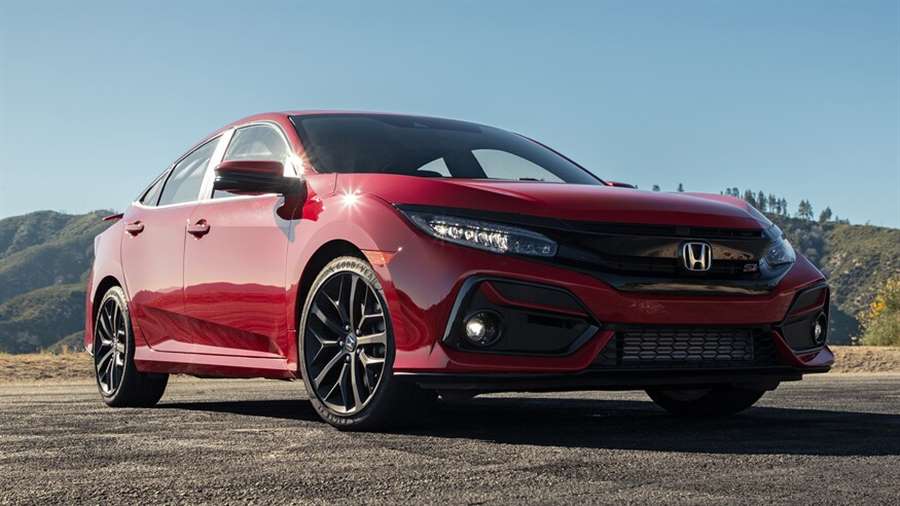
2020 Honda Civic Si Sedan: Momentous Performance
The Civic Si is what we call a momentum car. With 205 hp, it's no performance monster, but at 2,900 pounds, it's light enough to chuck about without constantly needing to slam on the stoppers. There's a delightful dance to be had in braking just enough to safely make the corner without losing any more momentum than absolutely necessary. The brakes, which aren't even upgraded past a set of performance pads, stand up to anything you can throw at them, which isn't much because again, you don't really have to slow down much for most corners. On the way out, the Civic Si's limited-slip lets you get back on the power early and pull it out of the corner, making the most of every pony. The manual transmission, the best of any this side of a Porsche, never lets you miss a shift, and the pedals are perfectly spaced for heel-toe downshifting.
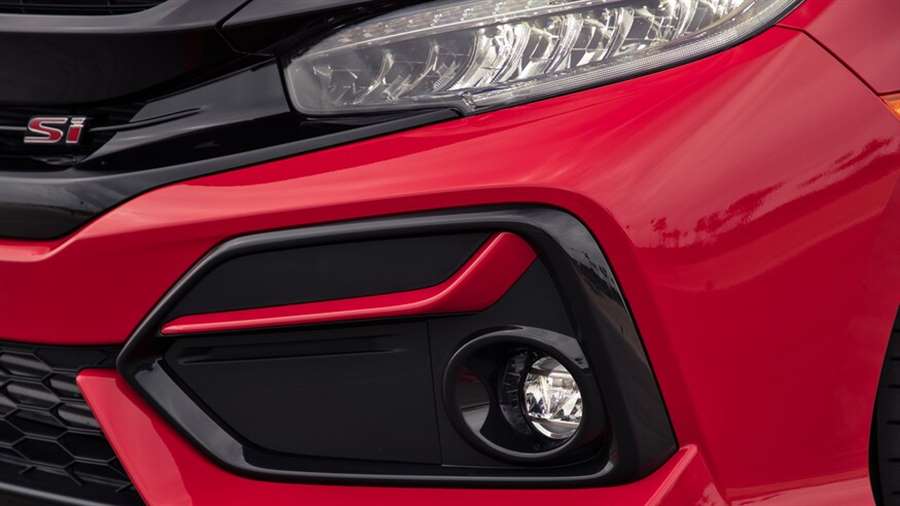
Its shortcomings are few and far between. If you're something of a drag racer, this isn't the car for you. Although the Civic Si feels quicker than it is, it's still held back by an engine that lags below 3,000 rpm and runs out of steam a thousand rpm before redline. The little Honda sedan is best when hustled on a road where you can keep both its speed and the engine's speed up. Around town, you're best off shifting before the turbo switches on, and when you're hustling, short-shifting. You'd also be well advised to keep a rag in the car to protect your hand from the cool-looking but scalding-hot or freezing-cold aluminum-topped shifter. When you're done driving, make sure to wait until the engine actually stops running after you switch off the car. If you release the clutch in gear too quickly ... well, it could get ugly.
It's easy to overlook the Civic Si when the Civic Type R is right there on the lot and only $11,500 more, but whether you're on a budget or just not ready to make the compromises its more powerful kin demands, the Si delivers. It's rewarding to drive on the best roads and comfortable on the commute. Ultimately, the Civic Si demands very little in exchange for the fun it provides, leaving you with a practical sedan every other day of the week.
Source: motortrend.com
Honda Civic Prototype Revealed, and It’s Pretty Much the 2022 Civic
Honda parlayed its sponsorship of esports, where it’s the official automotive sponsor of Team Liquid, to reveal the prototype of the next generation of its popular (and Cars.com comparison-winning) Civic compact car on the streaming platform Twitch. If you don’t know what Twitch is, ask your kids or U.S. Rep. Alexandria Ocasio-Cortez, D-N.Y.
Taking a page from Nissan and its Z Proto, the Civic prototype isn’t a fanciful concept but a very close to production-ready look at the new Civic sedan we’ll see early in 2021. We’ll have to wait longer to see the hatchback, however (Honda already axed the coupe). We’ll also need to wait for details on performance versions like the Si or the Type R. But enough about what this prototype isn’t — let’s talk about what it is.
Updated Exterior Styling
Up front, the Civic prototype ditches the current version’s large, fake “air intakes” at the corners of the bumper for angular elements that sit beside the split grille’s larger lower front opening. Slimmer-looking headlights give the prototype a sportier look than the current Civic’s non-Si or Type R design.
Along the sides are subtle, sculpted lines that evoke the new Acura TLX or, outside of the Honda family, Lexus IS, giving the prototype a more premium look. For wheels, Honda chose a set of black five-spokes that offset the metallic orange paint, a belated taste of Halloween. The rear forgoes the current Civic’s chevron taillights extending to the decklid for more traditional-looking thin units. The roofline borrows a lot of the current Accord, with a slope that blurs the line between sedan styling and liftback or hatchback styling.
Honda also wanted to improve cabin visibility and moved the A-pillars rearward, out of the driver’s line of sight. It also mounted the side mirrors to the doors for a clearer view out the side windows.
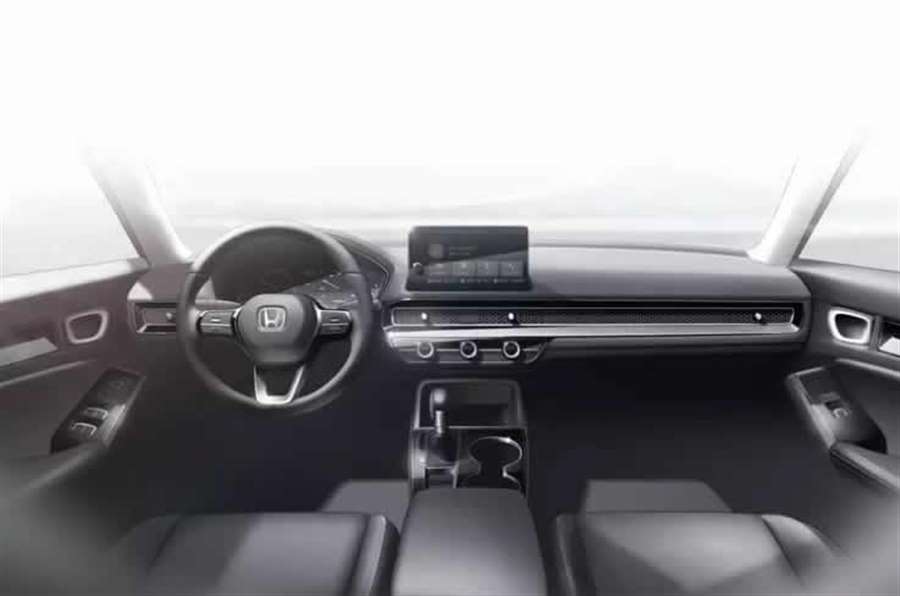
Cleaner Aesthetic Inside
Unlike the exterior, Honda only provided a sketch of the prototype’s interior, but it shows a cleaner and simpler look reminiscent of the e Prototype electric city car. New technologies that will debut on the next Civic include a digital instrument cluster and a 9-inch infotainment screen. A bummer: The infotainment screen shows only one physical control, likely the volume knob.
An interesting design touch is a single honeycomb mesh insert that runs horizontally across the length of the dashboard, concealing the air vents without impeding air flow because Honda deemed the vents “visually busy.”
Safety First
Safety remains a priority for Honda with the next Civic, starting with as-of-this-writing “multiple new active and passive safety systems,” including unspecified updates to the Honda Sensing suite of safety tech and “new airbag designs.”
Honda also said it updated the body structure to improve occupant and pedestrian protection in a collision. The more rigid body structure will also improve the Civic’s driving dynamics, Honda claims.
Pricing, Release Date and Other Things We Don’t Know Yet
Since this is a prototype, that does mean some details aren’t clear yet. We don’t know how powerful the next Civic’s engines will be, though Honda says they will be more powerful and more fuel-efficient. Transmission choices are also unclear, though the interior drawing shows an automatic gear selector. We also don’t have a clear picture regarding pricing, the aforementioned hatchback or performance variants.
Honda says the 2022 Civic will arrive in the late spring of 2021. Between now and then, we’ll likely see the additional variants, get more details about the official production version and, if we’re lucky, be able to drive it and tell you what it’s like.
Source: cars.com
Tested: 2021 Honda Accord Hybrid Polishes a Winning Formula
A range of subtle updates for the 2021 model year improve the Accord's tech quotient without altering its excellence.
The Honda Accord offers an unusually broad breadth of appeal. Among the family sedan's many trims and powertrains, there's truly something for everyone—and each version is mighty compelling in its own way. There are affordable models for those on a budget, Sport models with handsome curb appeal, the upscale Touring trim offering near-luxury interior appointments, and the Hybrid providing fuel efficiency without sacrificing refinement. Honda has revised the lineup for 2021, but there's little need for hand-wringing here. Besides the elimination of the six-speed manual transmission, there isn't anything in the refresh to diminish the Accord's overall excellence. And it improves in a few meaningful ways.
Nip and Tuck
If Honda's freshening of the Accord for 2021 seems especially light, that's because it is. Tweaks at the front include a slightly wider grille and updated lighting elements, which include all-LED arrays on EX trims and above. Inside, the previously optional 8.0-inch infotainment touchscreen is now standard, and Honda has added rear-seat USB ports, a wireless smartphone charging pad, and wireless connectivity for Apple CarPlay and Android Auto as options.
HIGHS: Smooth and efficient powertrain, upscale trims deliver a near-luxury look and feel, generous standard features.
Safety and driver-assistance features are improved for 2021 as well. Honda recalibrated the Accord's lane-keeping assist and adaptive cruise control systems to behave more naturally. After a brief drive on the highway in heavy traffic, we can confirm that the adaptive cruise control no longer exhibits the rubber-band behavior of the 2020 model, instead allowing the Accord to slow more gradually as it approaches traffic and quickly get back up to speed once the left-lane dawdlers move over.
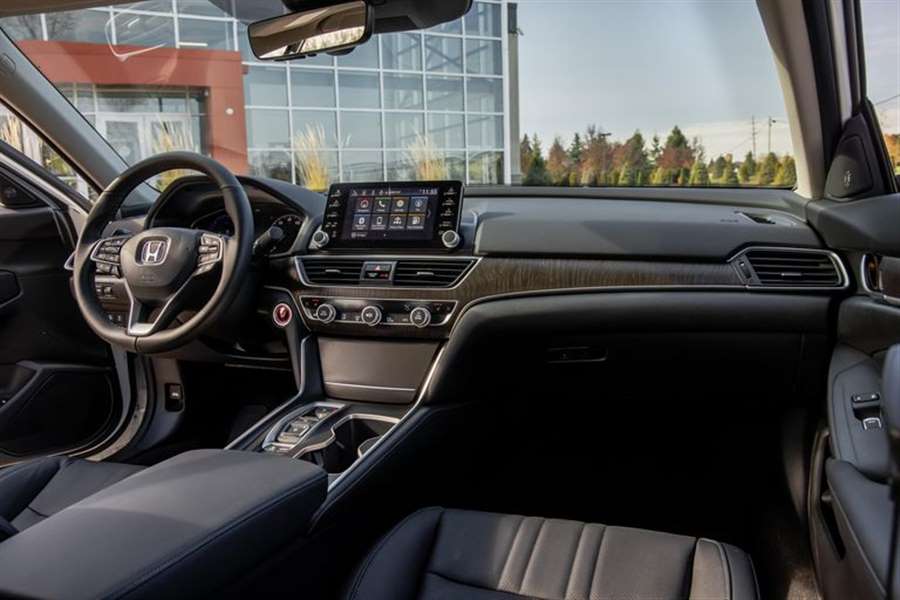
Our $38,050 Touring Hybrid test vehicle came loaded with features, including a head-up display, heated and ventilated front seats, leather upholstery and attractive 19-inch wheels. It also featured a new low-speed automated emergency-braking system that will apply the brakes if the driver is about to bump into an object at speeds between 1 and 5 mph. The only option was the sparkly Platinum White Pearl paint job, which cost $395.
Under the Hood
The Accord's crisp handling, balanced ride, and quiet cruising demeanor all carry over unchanged. The suspension tuning strikes a nice balance, with the Accord delivering confident handling while managing to expertly edit out road imperfections.
LOWS: Styling updates are a little too subtle, clamorous engine sound under heavy throttle, EV mode only goes for about one mile.
Honda made some slight adjustments to the hybrid system's power delivery for 2021, with the intention of providing stronger acceleration in Sport mode. The alterations are predictably subtle. At our test track, the 2021 model pulled off a 7.1-second zero-to-60-mph time, which is similar to the last version we tested in 2018. What's more noticeable are the changes to the power delivery in the normal driving mode, which exhibits a calmer demeanor under acceleration.
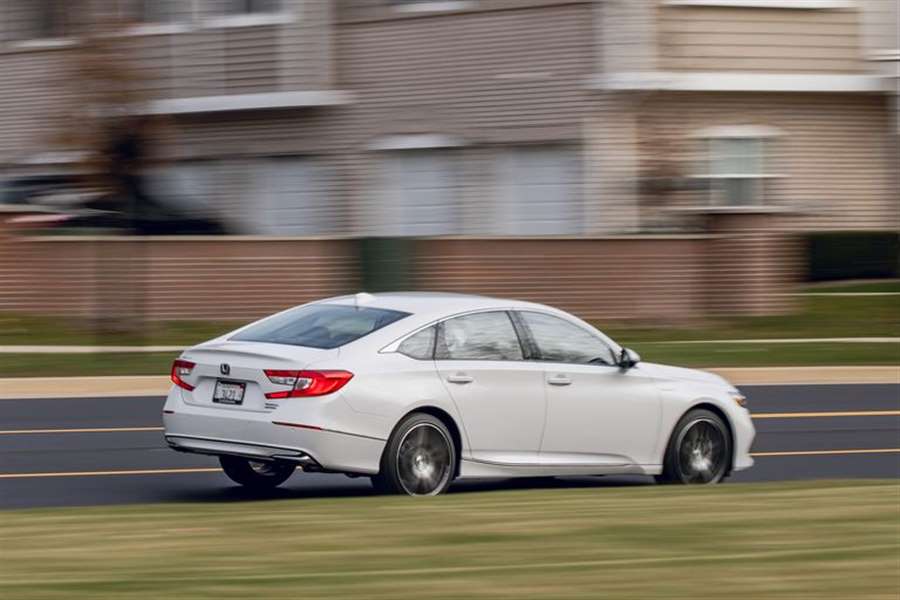
The Honda's hybrid powertrain is unlike any other in the market. The 143-hp 2.0-liter inline-four can generate electricity or directly drive the wheels in low load situations (think highway). In most situations, the 181-hp electric motor provides the propulsion. When you crack the whip, both the engine and motor combine for 212 horsepower, but off the line the Accord feels like a torquey EV because that's what it is; the electric motor makes 232 lb-ft of torque at 0 rpm.
As in the pre-facelift models, the 2021 Accord Hybrid still exhibits some coarse grumbles from the engine under heavy throttle. Fortunately, fuel economy remains practically the same, with the 2021 model's EPA combined estimate remaining 48 mpg and the highway score moving up a tick from 47 to 48 mpg. But that's for the lower-spec models riding on 17-inch wheels. The Touring trim rides on 19s and carries a 43-mpg combined and a 41-mph highway rating.
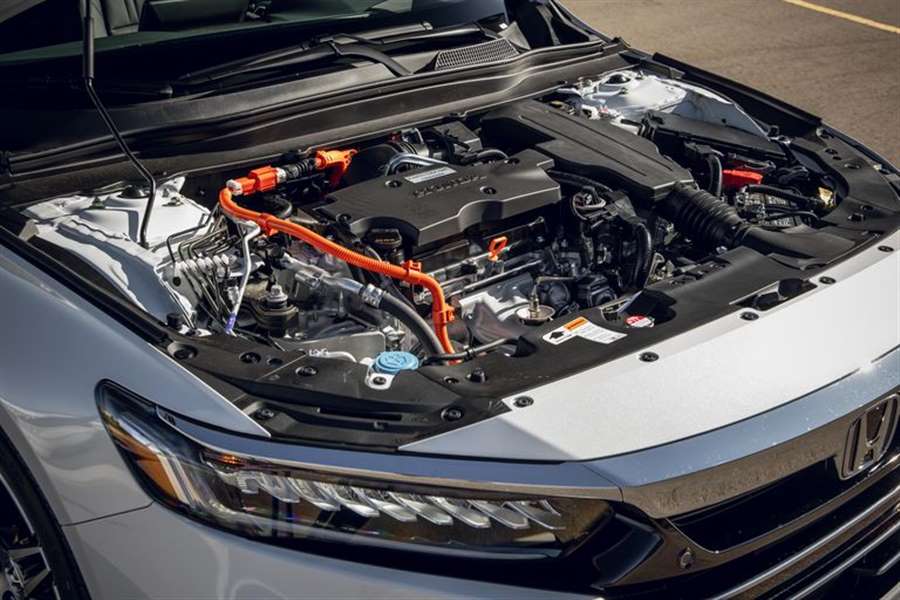
These updates, as minimal as they are, provide meaningful enhancements to the Accord's appeal without deviating from its winning formula. The alterations to the hybrid powertrain may not result in measurable improvements at the test track, but they help deliver a subjectively better driving experience. And the fact that Honda resisted the urge to jack up the price means that the Accord Hybrid Touring remains an outstanding anomaly—a luxurious sedan that gets economy-car mileage, no sacrifices required.
Source: caranddriver.com
Impact of Coronavirus on car industry in US
More than one million people are employed in automobile and auto parts manufacturing in the United States, and 1.3 million work for auto dealerships.
The companies bowed to pressure from union leaders and employees who called for protection from the pandemic that’s spread to more than 212,000 people in nearly every country across the globe.
According information which we receive from Ford Company the plans to close its factories from March 30 up to end of April in the U.S., Canada and Mexico. That pressure intensified after it was revealed on Wednesday that a worker at a Ford truck plant in Dearborn, Mich., had tested positive for the virus.
In addition to G.M., Ford and Fiat Chrysler, Honda, Toyota and Nissan also said they would idle their North American factories. The shutdown of car plants will force hundreds of companies that produce parts and components to follow suit over the coming days.
Ford, which has 55,000 U.A.W. employees, said those with at least one year of service would receive 75 percent of their regular pay through a combination of unemployment benefits and supplements paid by the company. G.M. is discussing a similar plan with the U.A.W.
From Honda we receive information that that will restart production at first week in April. They stop with production on Marth 23. They will provide full pay for the 27,000 employees in North America affected by the decision.
Nissan stop production on Mart 27, and also make a plan to restart production at first week in April.
According information from General Motors all North American factories will be closed and will evaluate the situation on a weekly basis after that.
Adjustment regarding stocks - that fallout from the coronavirus could send global auto production down 16% in 2020, fueled partially by an expected 20% decline in U.S. sales.

